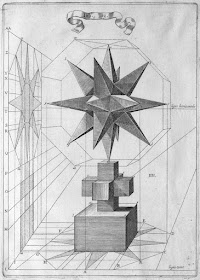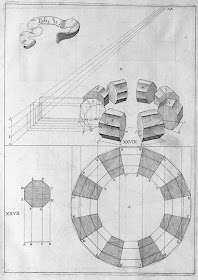The Artificial Magic in Optical Distortions
Catoptrics is an area of study concerned with the properties of reflection and the formation of images by reflecting light off mirrors.
Dioptrics is a branch of optics dealing with the refraction of light, especially by lenses
Anamorphosis is a distorted projection of an image which only becomes clear when the observer's point of view changes or it is viewed as a reflection produced by a specific curved mirror surface
The 17th century book illustrations below instruct artists about the basic geometrical properties involved in producing artworks with some types of projected and distorted perspectives and optical illusions.
Jean François Niceron (1613-1646) was a catholic friar^, mathematician, and an artist with a passion for investigating perspective. He was a native of Paris but travelled widely in Europe and was awarded a professorship in Rome.
Scientific societies^ were beginning to emerge in Niceron's time and he became a member of the 'Circle of Mersenne' (or Académie Parisiensis), named after Niceron's mentor, a polymath acoustics mathematician and theologian, Father Marin Mersenne^. It was through his association with this society that Niceron became acquainted with leading intellectuals in both Paris and Rome, such as Fermat, Desargues, Descartes, Gassendi, Roberval, Cavalieri, Kircher, Maignan and others.
Niceron's academic connections kept him well informed about the latest advancements in scientific thinking, particularly within the fields of optics and geometry. He attempted to apply this theoretical knowledge to the anamorphic paintings and murals that he was producing and he published his first book on the subject when he was 25 years old ('Thaumaturgus Opticus').
A later expanded treatise ensured Niceron's place in history. 'La Perspective Curieuse' (The Curious Perspective) consists of 4 parts ('books') and was first published in 1638. It concentrates primarily on the practical applications of perspective, catoptrics and dioptrics. The publication also associates the illusory effects of optics with a contemporary acceptance of natural magic (or proto-science). Niceron was sympathetic to the idea that optics was as much an art of illusion as it was a science of the properties of light.
"This richly illustrated manual on perspective revealed for the first time the secrets of anamorphosis and trompe l'oeil. It contained the first published reference to Descartes's derivation of the law of refraction. [..] {Niceron illustrates some of Descartes' theories by showing the camera obscura as an analogy for the eye}
Divided into four Books, the first Book presents briefly the fundamental geometrical theorems, and then develops a general method of perspective, borrowing heavily from Alberti and Dürer. The second Book addresses the problem of establishing perspective for paintings executed on curved or irregular surfaces, like vaults and niches, presents a general technique of anamorphosis. Here Niceron shows, for example, how to construct on the interior surface of a cone a distorted image which, when viewed from the end through the base, appears in proper proportion.
Book three discusses and fully explains the anamorphosis of figures that are viewed by reflection from plane, cylindrical, and conical mirrors. Book four deals with the distortions created by refraction. The added work on optics by Niceron's colleague and confrère Mersenne contained the author's final contributions to optics, including experimental studies of visual acuity and binocular vision and a critical discussion of current hypotheses on the nature of light." [source]
Niceron died at an early age leaving behind an incomplete Latin version of 'The Curious Perspective'. A number of editions were released from the 1640s to the 1660s that varied the amount of text from the first edition. They also incorporated works by other authors. It is generally agreed that the original edition (containing 42 copperplate engravings) was overall the most comprehensive publication and, in addition to the 4 'books' by Niceron, 'The Curious Perspective' also included a section authored by his teacher, Father Mersenne, about experimental studies of binocular vision and visual acuity.
In closing, I'll just note that this subject gets very heavy, very fast, once you dip your toes into the mathematical dimensions of optical physics, and I've hopefully avoided that here for all our sakes. Some commentary suggests that Niceron was a leading light, if not the first, to properly attempt an analysis of optical properties such as anamorphosis. While I have no real basis to disbelieve that assessment, a lot of treatises on perspective were published before Niceron's time by eminent scientists and artists and I think this deep subject requires a lot more study than a mere skim of a search engine results page to draw definitive conclusions. So I'm happy enough to copy a couple of chunks from the Wikipedia articles because they're not bad as light subject overviews..
"Leonardo's Eye (Leonardo da Vinci, c. 1485) is the earliest known definitive example of perspective anamorphosis. The prehistoric cave paintings at Lascaux may also possess this technique because the oblique angles of the cave would otherwise result in distorted figures from a viewer's perspective.
Hans Holbein the Younger is well known for incorporating this type of anamorphic trick. His painting The Ambassadors is the most famous example for anamorphosis, in which a distorted shape lies diagonally across the bottom of the frame. Viewing this from an acute angle transforms it into the plastic image of a skull. During the 17th century, Baroque trompe l'oeil murals often used this technique to combine actual architectural elements with an illusion. When standing in front of the art work in a specific spot, the architecture blends with the decorative painting.
The dome and vault of the Church of St. Ignazio in Rome, painted by Andrea Pozzo, represented the pinnacle of illusion. Due to complaints of blocked light by neighbouring monks, Pozzo was commissioned to paint the ceiling to look like the inside of a dome, instead of actually constructing one. However, the ceiling is flat, and there is only one spot where the illusion is perfect and a dome looks real.
In 18th and in 19th century, anamorphic images had come to be used more as children's games than fine art. In the 20th century some artists wanted to renew the technique of anamorphosis. Important to mention is Marcel Duchamp's interest in anamorphosis, some of his installations are paraphrases of anamorphoses (See The Bride Stripped Bare by Her Bachelors, Even/The Large Glass). Salvador Dalí also utilized the effect in a number of his paintings. Jan Dibbets conceptual works, the so-called "perspective corrections" are examples of "linear" anamorphoses. In the late 20th Century, mirror anamorphosis was revived as children's toys and games." [source]
- The images above were sourced from the 1663 edition of 'La Perspective Curieuse ou Magie Artificielle des Effets Merveilleux de l'Optique' (~The Curious Perspective or Artificial Magic from the Marvellous Effects of Optics - mouseover the link for the later edition's actual title), online at Les Bibliothèques Virtuelles Humanistes.
- The online version of 'The Curious Perspective' from La bibliothèque numérique de l’INHA contains fewer illustration plates.
- The 1652 edition online via Google ebooks is perhaps the easiest site in which to see all the plates in thumbnail form.
- Museo Galileo [La Biblioteca digitale dell’Istituto e Museo di Storia della Scienza (BD IMSS)] also has the 1638 version of 'The Curious Perspective' available online.
- BD IMSS also has its own digital libary of perspective with more than 30 digitised books (Opere a stampa = printed works)
- W: Niceron :::: Anamorphosis
- Art of Anamorphosis
- The History of the Discovery of Cinematograhy.
- Who's Who of Victorian Cinema.
- Mighty Optical Illusions.
- GW Hart's Rapid Prototyping Models webpage.
- 'Drawing the Maxim from the Minim: The Unrecognized Source of Niceron's Influence Upon Duchamp' by Stephen Jay Gould and Rhonda Roland Shearer IN: Tout-Fait, The Marcel Duchamp Online Studies Journal 2000.
- Vienna Mathematics conference paper 2001: Dynamic Geometry Software by Adrian Oldknow.
- Christie's auction page (1638 version sold for $8500 in 2004)
- Escalier des Sages rare book catalogue page.
- Short VCU staff member page.
- Short Museo Galileo page on anamorphosis (note sidebar links)
- BNF has a lot in its online catalogue, but I'm not sure how much is actually online. They used to have the only version of Niceron's book on the web (search his name from here).
- There is a LOT to be plumbed in the back pages of BibliOdyssey, particularly among the links at the ends of site entries (like here!). See:: Perspectiva :: Ars Magna Lucis et Umbrae :: Jamnitzer Perspectiva :: Panorama Handbills :: The Geometric Landscape :: Geometric Perspective (and, no doubt, others I'm forgetting)

















Weird. Fascinating.
ReplyDeleteTécnica plena.
ReplyDeleteIt's comforting to see that some of my own fumbling experiments in the field of calculated perspective weren't entirely a waste of time. :)
ReplyDeleteIt's on excellent web page! I love it.
ReplyDelete